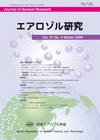Volume 20, Issue 4
Displaying 1-12 of 12 articles from this issue
- |<
- <
- 1
- >
- >|
Feature Articles —Nature and Atmospheric Aerosols—Traditional Subjects with New Insights—
-
2005 Volume 20 Issue 4 Pages 280
Published: 2005
Released on J-STAGE: January 12, 2007
Download PDF (538K) -
2005 Volume 20 Issue 4 Pages 281-289
Published: 2005
Released on J-STAGE: January 12, 2007
Download PDF (848K) -
2005 Volume 20 Issue 4 Pages 290-296
Published: 2005
Released on J-STAGE: January 12, 2007
Download PDF (730K) -
2005 Volume 20 Issue 4 Pages 297-305
Published: 2005
Released on J-STAGE: January 12, 2007
Download PDF (1290K) -
2005 Volume 20 Issue 4 Pages 306-312
Published: 2005
Released on J-STAGE: January 12, 2007
Download PDF (675K) -
Article type: Others
Subject area: information
2005 Volume 20 Issue 4 Pages 313-322
Published: 2005
Released on J-STAGE: January 12, 2007
Download PDF (1205K) -
2005 Volume 20 Issue 4 Pages 323
Published: 2005
Released on J-STAGE: January 12, 2007
Download PDF (542K)
Research Paper
-
2005 Volume 20 Issue 4 Pages 324-332
Published: 2005
Released on J-STAGE: January 12, 2007
Download PDF (1052K) -
2005 Volume 20 Issue 4 Pages 333-344
Published: 2005
Released on J-STAGE: January 12, 2007
Download PDF (908K)
Technical Paper
-
2005 Volume 20 Issue 4 Pages 345-351
Published: 2005
Released on J-STAGE: January 12, 2007
Download PDF (1005K)
Letter
-
2005 Volume 20 Issue 4 Pages 352-354
Published: 2005
Released on J-STAGE: January 12, 2007
Download PDF (938K)
Series Article —Varieties of Pathological Lesions Induced by Aerosol—
-
2005 Volume 20 Issue 4 Pages 355-360
Published: 2005
Released on J-STAGE: January 12, 2007
Download PDF (776K)
- |<
- <
- 1
- >
- >|
